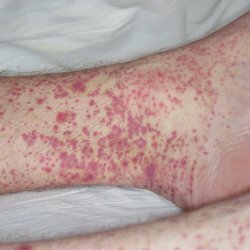Systemic lupus erythematosus in men

Systemic lupus erythematosus( abbreviated SLE) is a rheumatic, chronic, unknown etiology disease characterized by hyperproduction of a wide range of organ-specific autoantibodies to various nuclear substances and immune complexes that provoke an immuno-inflammatory lesion of internal organs.
This disease belongs to the most severe systemic connective tissue diseases. For every 100,000 people in SLE, 4-250 cases occur, of which 90% are women.
The described disease has a characteristic feature - a large range of clinical variants of the course of the disease and their manifestations. Diagnosed SLE based on the results of laboratory research methods, these instrumental methods, based on clinical symptoms, classification criteria of the College of Rheumatology of America.
In 1930-1940, during clinical trials, scientists demonstrated that the disease most often affects women, later these data were confirmed by the development of specific serological diagnostic methods. Systemic lupus erythematosus in men occurs only in 4-22% of cases. In 1923, the first case of a disease( satisfying modern AKP criteria) among men was described.
The ratio of men and women who suffer from SLE is on average 1: 6, and in the post-pubertal stage is generally 1:10.
In persons who have not reached the 15-year threshold, and who have crossed the 65-year-old threshold, sex differences in SLE lesions are significantly less. Men are exposed to disease at a much older age. According to one data, the average age of men is 40.4 years, whereas in women the average age is 31.8 years. There are data that among men the peak incidence of this disease falls on 50-59 years.
One of the reasons why women are most often described as a disease is gonadal hormones. During the research it was proved that sex hormones affect the immune system, as a result of which it was noticed that in women much more often than men develop various autoimmune diseases.
In a number of studies, a comparative assessment of clinical, epidemiological, immunological and laboratory parameters of SLE was conducted in women and men. With "male" SLE, the results on the severity of visceral lesions, the nature of the flow are contradictory and few. Almost all authors, agreeing with the fact that men have a disease characterized by the characteristics of the disease, distinguished the features of the symptomatology in men.
Scientists like Sthoeger Z.M.And Debeyre N concluded that in male patients, SLE occurs more easily, remissions are more frequent, visceral lesions are less pronounced.
Many authors believe that men are more characteristic of thrombocytopenia and central nervous system damage, which was not noted by other researchers. In men, in some groups, a significant percentage of serosites was recorded.
In women, according to Blum A and Koh W.H.The defeat of peripheral joints is most often observed. Folomeev M.Yu. In men, he discovered a high incidence of sacroiliitis and arthritis of the lower extremities( 30%), he also drew attention to the similarity of the joint syndrome that is observed in men suffering from SLE with syndromes in seronegative spondylitis.
Miller M.H.In the course of studies, no sexual difference was found in the incidence of kidney damage.
Ward M. drew attention to the fact that men suffering from SLE have a marked tendency to maturation of renal failure.
A similar regularity was noted in the work of Tareeva IE: in men, the symptoms of renal failure usually appear early and rapid-progressive lupus jade accompanied by malignant hypertension is formed.
Observations Folomeeva M.Yu. Showed that "male" SLE proceeds more difficultly, with rapid generalization of the process and minimal number of remissions.
For clinicians, the rarity of "masculine" SLE sometimes becomes a figurative stumbling block, as doctors are treated as "female" to this disease.



